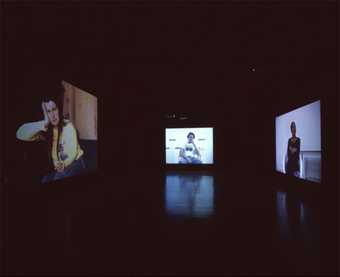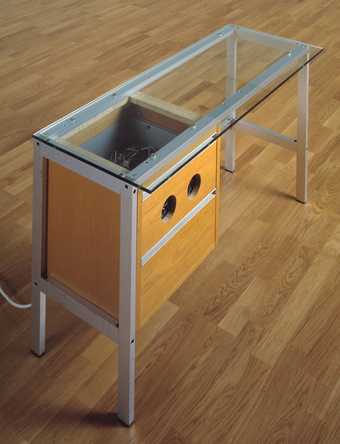
Angus Fairhurst
Gallery Connections
(1991–6)
Tate
A time-based media installation is best understood in its installed state as a dynamic system. The system transforms a media element into sound and image, which unfolds to the viewer over time, within the context of a prescribed environment. The installation may also include sculptural elements. A system can be defined as ‘an assembly of components, connected together in an organised way. The components are affected by being in the system and the behaviour of the system is changed if they leave it.’1 In determining the identity of the work conservators are interested in the relationship of the components of the system to the meaning of the installation. Some of the components may have significance broader than purely functional value.
Display equipment warrants special attention because it presents specific challenges to our ability to display these works in the future as the artist intended. Assigning significance to components of the installation is independent of the museum’s ability to preserve what is valued. Unavoidable change does not mean that the work was designed to change. Artists and other stakeholders are at liberty to assign significance to a specific piece of display equipment, even if that object is set to become obsolete and fail. Here lies the nub of the problem: display equipment is certain to fail and become obsolete, therefore any strong link between specific display equipment and authenticity or value will mean that a degree of loss is inevitable. The stronger and more specific the link, the more vulnerable the work is to loss. Does it make sense to associate the identity of these works with elements that cannot be preserved? As with other types of vulnerability, for example light sensitivity of pigments in a painting, difficulty in preserving what is valued does not mean something is less valuable, rather that we may have to accept a greater degree of loss than in works that exhibit a different or lesser vulnerability.
Identity and authenticity
Discussions about authenticity and time-based media works of art will become more prevalent in time. Making decisions about what is important to preserve means deciding what is essential in identifying a particular installation as a faithful instance of that work. However, what is important to the identity of these works is often uncertain.2 Although one cannot draw a direct analogy to musical works (time-based media installations are not specified by a score and media elements are decoded without the interpretative role of a performer) certain considerations are analogous. For example, there are degrees to which particular instruments are important to the identity of a musical work. Knowledge of the composer’s instructions provided in the score, understanding of the historical context, performance traditions and the conventions guiding musical performance help to determine what is important to the identity of the work.3 As with musical performances, a particular instance of an installation of a time-based media work that fails to be an authentic installation does not preclude the possibility of an authentic installation in the future. The role of the conservator is to understand what might constitute an authentic installation and to work to make such an installation possible.
Considering scenarios about the future helps to identify the values underpinning decisions in the present.4 In the following quote the artist Bill Viola has done just that:
I can envision some historical researchers and technicians in the basement of some museum one hundred years from now relearning the art of blowing glass and circuit wiring to recreate CRTs from scratch so the late-twentieth-century Nam June Paik piece in the collection can be presented as originally seen. Whether it will be the adapted/updated technology approach or the purist, original technology-at-all-costs approach, preserving the hardware, or at least detailed information about it, will have to be considered an essential element in the preservation of these works.5
How one reacts to the ‘purist, original technology-at-all costs approach’ depends on how the relationship of the equipment to the identity of time-based media works of art is viewed. Significance is context dependent.
Context and values
Unlike a science museum or historical museum, the primary focus of a fine art collection is display rather than the presentation of evidence or the demonstration of function. This affects priorities and the criteria by which we judge value.6
Ontology and authenticity in conservation
The most common conception of a work of art is as a unique object. In conservation the prevalent notion of authenticity is based on physical integrity, this guides judgements about loss. For the majority of traditional art objects, minimising change to the physical work means minimising loss, where loss is understood as compromising the (physical) integrity of a unique object, and this forms the focus of conservation. Where this conception of preservation is most contested is in ethnographic and contemporary art conservation. Increasingly ethnographic and contemporary art museums are being asked to acknowledge legal and moral rights of stakeholders who do not, in literal sense, own the work. Included in these claims is the right to have a voice in what is meant by preservation. In ethnographic collections, stakeholders have been found to value non-physical properties of works that relate to their use and context.7
Most display equipment is mass-produced and unless modified or rare it is not valued for uniqueness and can be substituted with the same make and model creating little or no discernible change. When exact substitution is impossible and change occurs, the change is assessed by considering the significance of equipment to the installation.
Identifying functional significance
The significance of display equipment to a time-based media installation depends on how it is used. There are two categories:
- Equipment that has purely functional value
- Equipment that is significant for reasons over and above its functional role.
A ‘yes’ to both of the following questions indicates that the equipment has purely functional value to the installation:
- Is the equipment hidden from the viewer?
- Can the function of the equipment be accurately mapped so that substitution with equipment of the same function brings about no discernible change?
If the answer is ‘no’ to either of the above questions then the considerations given below are applicable.
Identifying aesthetic, historical and conceptual significance
The questions given in Table 1 are designed to identify relevant considerations in determining aesthetic, conceptual or historical significance of equipment. These are to be understood within a contemporary art context. Conceptual integrity refers to the relationship of the work to the process or technology employed and the spirit in which the work was made. Aesthetic integrity relates to the look and feel of visible components and the outputs of the system (i.e. qualities of the sound and image). Historical integrity refers to links made by the visible components and discernible outputs of the system to the time the work was made. In conjunction with a rating describing the predicted time in which the piece of equipment is likely to become unavailable,8 these questions can be developed into a score chart in order to identify priorities for action and the allocation of resources.
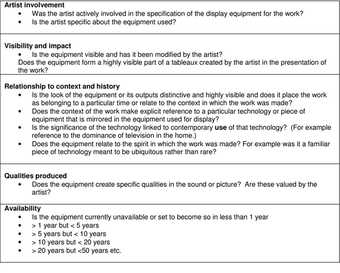
Table 1
Questions used to identify significance in equipment whose value is not purely functional
In the case of Angus Fairhurst’s Gallery Connections (fig.1), the Walkman™ cassette player is visible through the glass top of the desk (see also the drawing in fig.2 showing the development of this work).
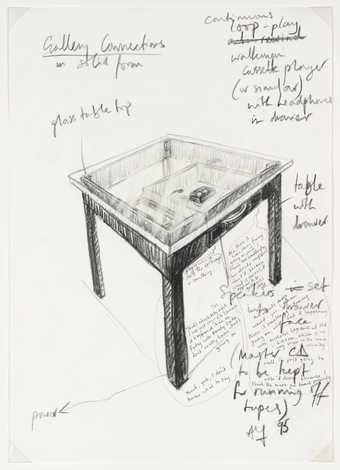
Angus Fairhurst
Gallery Connections
(1995)
Tate
The Walkman™ reflects technology common at the time the work was made and therefore links the work to a particular historical moment. Fairhurst has expressed the view that the ‘authenticity’ of the work would be undermined if a hidden compact disc player fed the audio (although a master CD might be used to make tapes for display) and he considers it important that the mechanics of the installation are transparent.9 The value of the Walkman™ is therefore greater than its function in playing back the audio. Because its value is high, obsolescence creates a greater risk of being able to display the work in the future without loss.
Who should answer questions about significance?
The questions in Table 1 aim to map the problem space and they might be answered by interviews with the artist, curator and technician, as well as the observations and judgement of the conservator. Gathering and evaluating this information and building consensus are difficult. Where the artist has modified the display equipment, to the extent that it becomes a sculptural object, its significance conforms more readily to that of a traditional museum object. However in the majority of cases the status of the display equipment is not so clear-cut. The specific relationship of the equipment to the work is often difficult to quantify. Some artists clearly articulate why they chose certain equipment and have built up a body of experience about the impact of different equipment on the installation. Other artists are less able to comment regarding the choices made and only articulate views about the specifics of the equipment originally used once it changes. Some artist’s feel uncomfortable focusing on aspects associated with the staging of their work, and its impact on the viewer, for fear the work might be considered ‘theatrical’.
Formalisation and dialogue
In considering identity it is useful to look at the conventions that operate when a work enters a contemporary art museum and a process of formalisation begins. This is a collaborative process that forms the basis of developing an in-depth knowledge of the work and takes the form of a dialogue between the artist (or their representative), the conservator and the curator. During this process attitudes to change are discussed, often with reference to the way in which the work has been previously installed, focusing on what makes a good installation. Early in the life of the work, attitudes to change are fairly relaxed as the artist experiments and responds to different spaces and contexts. In most cases the form of the work becomes determined through the first few installations. During this process the authority lies with the artist. As time passes, the artist may lose interest and become less involved and ultimately the museum is expected to outlive us all.
Differing values
A divergence of values between the artist and the museum is likely to become apparent over time. The degree to which the look of a particular technology dates the work is often only apparent once the technology moves on. Artists, unlike the museum, have the option of being disinterested in historical links and may feel ambivalent about the speed in which the work is dated by technology. The questions used to help identify significance express values that may be weighted differently by the artist and the museum. Early in the relationship with a new work the museum often accommodates the exploration and development of the identity of the work, only later acting more conservatively to contain the work in its established form. This shift in stance can be difficult for the artist to comprehend. Although the museum may perceive itself as the passive custodian of the work of art, it has its own values related to the idea of the objects having evidentiary value connecting us to the past. Conservators are likely to link their ideas of acceptable parameters of change to an existing work of art rather than a pre-existing idea held by the artist.10 The museum might therefore become more interested than the artist in a contextualist ontology that relates the work to the art historically and technologically determined natal environment.11 This is partly because the museum believes it has a duty to protect the work from the ‘ever changing tastes and politics of society.’12
In summary, the differing values of the museum and the artist and the inevitability of a shift in authority over time presents a complex array of criteria by which to judge conservation decisions; criteria which are liable to be weighted differently by different stakeholders at different times.
A Practical response
Basic documentation, monitoring and management of the display equipment and understanding how it functions in the installation, form the basis of a museum’s response.
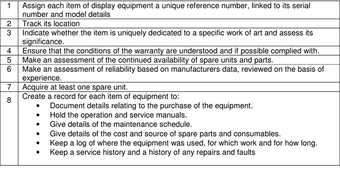
Table 2
Basic guidelines for the management of display equipment
Developing strategies
The quote from Bill Viola given at the beginning of this paper identified two approaches; the ‘purist, original technology at all costs approach’ and the ‘adapted/updated technology approach’.13
I have argued that the development of an appropriate conservation approach depends on the significance of the display equipment to the installation, and this is case specific. Here the concepts of identity and loss are associated with aesthetic qualities of the equipment’s output as part of a dynamic system and conceptual and historical associations.
Possible strategies are not mutually exclusive and it is common to find them all adopted throughout the life of a work. Like most, if not all, conservation strategies they are not perfect – either implementation is only possible for a limited period or they admit degrees of loss to the work. Evaluation of their success involves weighing the gain of being able to keep the installation running against loss to less tangible aspects of the work.
Strategies include:
- Acquiring spares to repair the original unit or substituting the failed unit with the same make or model. This maintains the integrity of the work on all counts except for any work explicitly designed to be ephemeral. This strategy is the closest to traditional conservation practice in that it preserves the link to the meaning of the work by preserving the identity of the physical components. Success is easy to evaluate – if the same equipment is used then (if all other conditions for installation are adhered to) no loss will occur. This strategy is only an option for the time spares are available.
- Making new components or modifying another piece of equipment to match what was considered significant about the failed equipment. For example, putting a modern mechanism into an original casing. When considering this strategy one should bear in mind the risk of undermining the spirit of the work if the technology is intended to be transparent and uncontrived.
- Recreating significant features by inexact substitution perhaps by an item of equipment using the same technology or producing the best match of measurable outputs (quantifiable in terms of dynamic range, resolution, brightness etc.).
When to act: understanding reliability and obsolescence
This paper has explored the link between the vulnerability of time-based media installations to the presence of significant components that are set to become unavailable in a relatively short period of time; the greater the significance and the more pressing the risk of obsolescence, the higher the vulnerability.
Once the conservator has determined that a piece of equipment is significant, it is important to have a sense of how soon the equipment is likely to fail. Unlike our view of other common and major risks to works in museums, the risk of failure and obsolescence in display equipment is one we have very little ability to avoid or block in the medium term. How quickly we must act is determined by decisions made by the manufacture to continue to support the product, its reliability and how well the equipment is maintained.
Calculating reliability
Reliability is defined as ‘the probability, assuming the system was operating at time zero, that it continues to operate until time ‘t’’.14 Assessing the reliability of a complete system with mathematical precision is extremely complex and for our purposes largely redundant.15 Broad assessments of reliability and obsolescence can in most cases give a good enough indication of priorities.16 More expensive professional equipment tends to be supported for longer and be more reliable, it also has a broader base of knowledge associated with it and engineers are more willing to consider a repair. High market saturation often means that support and spares will be available for longer.
Manufacturers of display equipment will, although often reluctantly, provide data on the reliability of their products. Interpreting this data is not always easy. Often it is provided is in the form of MTTF(mean time to first failure) rates or more commonly MTBF17 (mean time between failure) rates. MTBF rates refer to data produced for repairable systems and assume that we are working in an environment where spares are available and we can find someone to repair it. MTTF rates will not tell you the distribution of failures nor when your unit will fail. When assessing reliability data it is important to know how many units were tested, over what period of time, under what conditions, the distribution of the failures and the definition of failure. In the case of a comparative test of LCD (liquid crystal display) versus DMD (Digital micro-mirror device) projectors, the LCD panels exhibited yellowing over time.18 The tolerance to yellowing when a projector is being used to display a work of art is low. It is therefore necessary for the museum and the artist to develop their own standards regarding what they consider acceptable signs of deterioration and here calculations such as those used for light faded objects, namely perceptible difference, are relevant.19
Rapid obsolescence means that only by acting early to acquire spares can we create the option of exact substitution or repair in the future. In deciding where to spend a limited budget, cost–benefit analysis is a useful tool. It is also important to consider the other dependencies in the system; there is no point in massing spare cassette players if cassette tapes are no longer available. In developing a strategy for the continued display of a work, having a sense of the planning horizon of a museum is also vital. One of the rare moments where this is likely to be made explicit is in relation to the policy for the display of light sensitive objects. Here there are analogies to be drawn when developing policies for the display of vulnerable time-based media installations.
Inevitably, there comes a point when it is very difficult to maintain the installation with original equipment. If a particular item of equipment is considered of high significance then it is prudent to hold a pristine example. Recognising that notions of authenticity are likely to be more prominent in the context of an historic collection, an example of the original equipment may attain a higher value in the future than early of the life of a work. Although examples would, by necessity, be held for reference only, they may be considered valuable evidence for the technicians described in the future scenario given by Viola at the beginning of this paper.
Conclusion
In this paper I have outlined the considerations pertinent to deciding how one might approach the vulnerabilities of display equipment in time-based media works of art. This is a new area of conservation but one where we are likely to see the impact of our decisions within our career. Part of what constitutes good decisions will be the recognition of the importance of a transparent and inclusive process to inform a rich analysis of what should be preserved.


